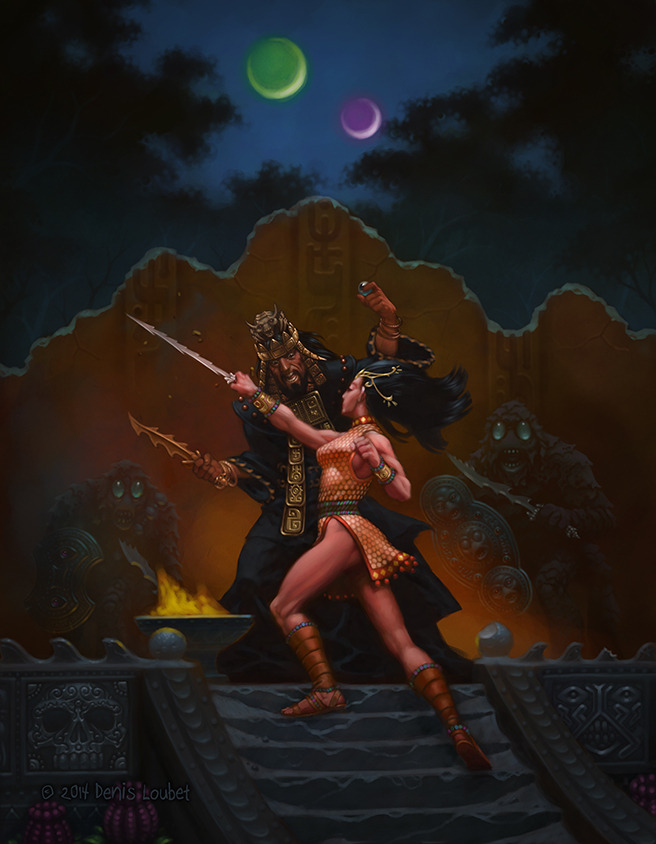So, here is the idea: creating my own scorched fantasy wasteland, mixing Dark Sun with different doses of its influences and some of my own favorites. I am leaning towards a more sci-fi version of the setting, but without guns, laser, automobiles or space ships. When I am finished, I might put everything together into a short PDF so you can use it as you will (with some notes on adapting it to old school games and 5e, with alternate classes, rules, etc, if there is enough interest).
This post is about the stuff I'll use for inspiration; I listed things that might have influenced Dark Sun itself to some degree to a couple of new things that I think would fit well. This is not a literary analysis of Dark Sun, but a list of cool things that might be useful for my fantasy post-apocalyptic campaign. If you like this list, you might like the rest of the series. Here we go.
 |
| Source. |
1. Dark Sun and Mad Max are the main reasons I'm writing this. Always been a fan of both, and Fury Road, of course, was one of the best action flicks in recent memory, with lots of gameable material - warlords, preservers, warboys, etc. Most Dark Sun books are still available to buy in PDF, and you can always turn to the Dark Sun Wiki for easy access to information.
2. Tékumel by M. A. R. Barker is, in many ways, Dark Sun "avant la lettre". Empire of the Petal Throne was published, in 1975, in the same year as Greyhawk and Blackmoor, using non-european mythologies to create an unique and very detailed setting. Hot weather, iron scarcity, strange beasts and bizarre races were played using D&D rules decades before anyone ever heard of a Thri-kreen. The best introduction to Tékumel, according to a recent post by James Maliszewski on G+, is Empire of the Petal Throne, available here.
 |
| Source. |
The sand of the desert of Yondo is not as the sand of other deserts; for Yondo lies nearest of all to the world's rim; and strange winds, blowing from a pit no astronomer may hope to fathom, have sown its ruinous fields with the gray dust of corroding planets, the black ashes of extinguished suns. The dark, orblike mountains which rise from its wrinkled and pitted plain are not all its own, for some are fallen asteroids half-buried in that abysmal sand. Things have crept in from nether space, whose incursion is forbid by the gods of all proper and well-ordered lands; but there are no such gods in Yondo, where live the hoary genii of stars abolished and decrepit demons left homeless by the destruction of antiquated hells.
4. Frank Herbert's Dune is another favorite. With noble families vying for power, political intrigue, psychic abilities, teleportation and giant Sandworms instead of dragons, I think one could use even more inspiration from Herbert to create something that would be at the same time more novel and more palatable to audiences accustomed to Game of Thrones and House of Cards.
| Source. |
Upon reaching 1,000 years of age almost all Martians undertake a pilgrimage on the River Iss, expecting to find a valley of mystical paradise; what they find is in fact a deathtrap, populated by ferocious creatures and overseen by a race of cruel, cannibal priests known as Therns, who perpetuate the Martian religion through a network of spies across the planet.
His works are in the public domain in the U.S. and can be found here.
| Source. |
7. Brom is, of course, the quintessential Dark Sun artist, who created much of the look and feel of the setting, but you can look for inspiration in other artists, too. Here is a couple of ideas.
Richard Corben's comic book DEN is mentioned as an influence to Dark Sun by Steve Winter, according to Wikipedia - it looks somewhat like Barsoom with lots of nudity. Besides doing an adaptation of The Vaults of Yoh-Vombis, Corben apparently created the first graphic novel, Bloodstar, a Robert E. Howard adaptation that depicts the heroes fighting lovecraftian monsters in a post-apocalyptic land.
I am a fan of Moebius desert landscapes and weird vistas myself, and Moebius drawings for Dune can inspire a different vision from the more familiar one from David Lynch.
| Source. |
9. Robert E. Howard and H. P. Lovecraft. Since they have been mentioned a few times already, I feel they deserve an entry. Lovecraft you can use for monsters and gods, and Howard for the Sword&Sorcery vibe. As you know, Conan is often fighting monsters from the Cthulhu Mythos.
10. And, why not, Tatooine, from Star Wars. That's what people have been talking about these days, right? Sarlaacs, sand raiders, banthas, shady taverns and powerful hermits with mind-controlling powers would all fit the bill.

China Mieville's Iron Council might be something you want to consider. Bas Lag has lots like the cactusmen and magic missing radiation badlands to offer
ReplyDeleteChina Mieville's Iron Council might be something you want to consider. Bas Lag has lots like the cactusmen and magic missing radiation badlands to offer
ReplyDeleteThanks Heath! I kinda like Perdido Street Station, but I have yet to read Iron Council.
ReplyDeleteA Mad Max-inspired setting without automobiles? How dare you?
ReplyDeleteAnyway, can't wait to see what comes out of this!
Hahaha! Thanks! I'm sure we can think of SOMETHING to replace automobiles... ;)
Delete